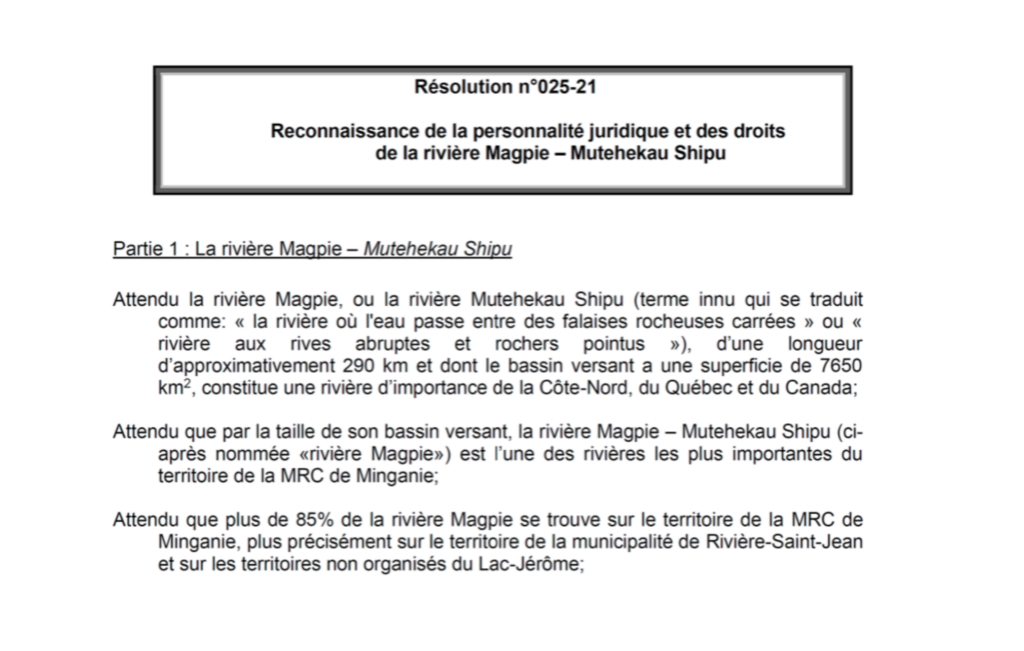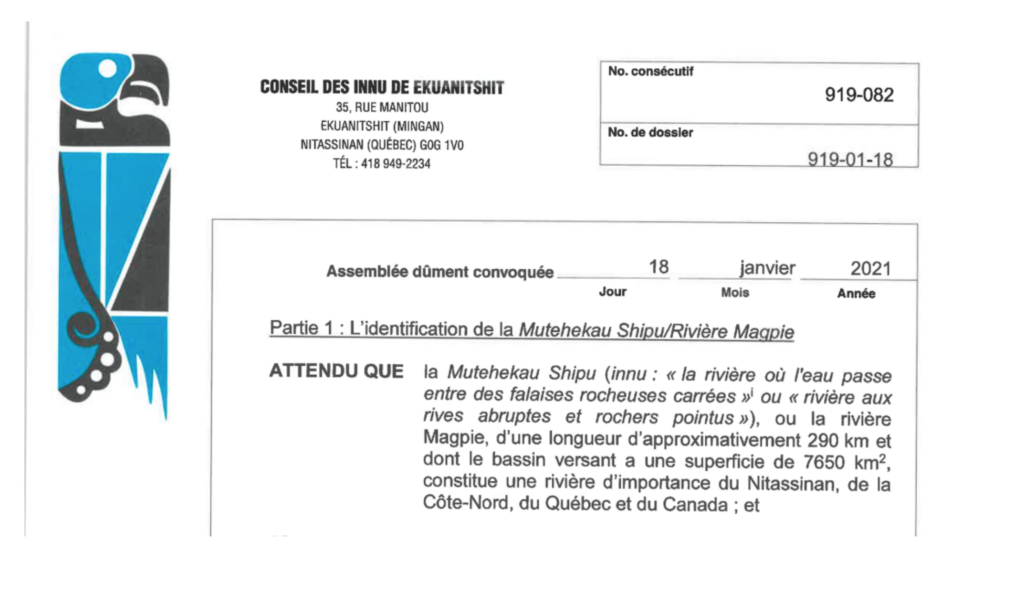By Yenny Vega Cárdenas, President, International Observatory on the Rights of Nature.

On February 23, 2021, the Alliance for the Protection of the Magpie River/Muteshekau Shipu (in Innu) in partnership with the International Observatory on the Rights of Nature, announced the recognition of legal personality and rights to this majestic river. This declaration aligns itself within the ecocentric current that considers that Man is no longer the “master” of Nature, but a species among others. It implies the recognition of values and an intrinsic dignity to the Magpie River, as it becomes a subject of law.
Nearly 300 km long, the Magpie River is located in the Nitassinan (the ancestral territory of the Innu people), in Eastern Quebec and in the territory of the MRC de Minganie. Its Innu name, Muteshekau Shipu, means “the river where water flows between square rocky cliffs”. The Magpie River, as expressed by Uapukun Mestokosho, young leader of the Innu community, is “the Nutshimit: where my blood comes from“. This river is an integral part of the culture and distinctive identity of this community.
For the first time in Canada, the Magpie River has been attributed through two mirror resolutions, one by the Regional County Municipality of Minganie and the other by the Innu Council of Ekuanitshit, nine rights : 1) The right to live, exist and flow; 2) the right to respect its natural cycles; 3) the right to evolve naturally, to be preserved and to be protected; 4) the right to maintain its natural biodiversity; 5) the right to maintain its integrity; 6) the right to perform essential functions within its ecosystem; 7) the right to be protected from pollution; 8) the right to regeneration and restoration; 9) the right to take legal action.


River guardians with specific and detailed duties will soon be appointed to ensure the protection of the rights of the MagPie/Muteshekau Shipu River. This declaration is part of a global paradigm shift that proposes a major transformation in the categories of “object” and “subject”, making Nature a holder of the right to be protected, as opposed to an object of protection.
David Boyd, UN Special Rapporteur on Human Rights and the Environment, considers that:
“the recognition of the rights of the Magpie River is a revolutionary legal breakthrough in Canada. This innovative step indicates a deep desire for healing our damaged relationship with the rest of the natural world, and a recognition of the importance of integrating Aboriginal legal concepts into the Canadian legal system.” David Boyd, UN Rapporteur.
The team of the International Observatory for the Rights of Nature fully corroborates the words of the Rapporteur when he says:”I hope this step to recognize the rights of Nature is the first of many similar actions on behalf of rivers, lakes, mountains and other ecological wonders in this beautiful country we are so lucky to call home.” David Boyd, UN Rapporteur.
Maude Barlow, former President of the Council of Canadians, and former Senior Water Advisor to the President of the United Nations General Assembly, is a strong supporter of the first recognition of legal personality and rights to a river in Canada. In this regard, she says:“This is a very important step and a wonderful example of indigenous values and leadership coming together with the global movement to recognize the rights of Nature. People will be watching this from all over the world. ” Maude Barlow.
Internationally renowned, the Magpie – Muteshekau Shipu River ranks among the top ten rivers in the world for whitewater activities. The River is of fundamental importance to the environmental, social and economic well-being of all residents of the Regional County Municipality of Minganie and has a recognized potential for adventure tourism.
As Pier-Olivier Boudreault, Director of Conservation and responsible for the campaign to protect the Magpie River at CPAWS-Quebec, explains, “the Magpie River is an international jewel that we must absolutely protect. The recognition of the rights of this majestic river is a leadership demonstration of the Innu First Nation Ekuanitshit and Municipalities of Minganie for the Protection of Nature”.

Having contributed to the drafting of the two mirror resolutions, the team of the International Observatory for the Rights of Nature is grateful for the valuable contribution of the Observatory’s associate researchers, experts in Nature law and Indigenous Law, as well as for the collaboration of the law students and interns associated with the project. This is a collaborative work, not only to advance the law, but also to improve our relationship with Nature.
The text of the resolutions can be accessed via the following links: for the Ekuanitshit Council: http://files.harmonywithnatureun.org/uploads/upload1072.pdf and for the MRC of Minganie: http://files.harmonywithnatureun.org/uploads/upload1069.pdf.
OIDN is proud to have participated in the paradigm shift that involves no longer considering Nature as a mere “object” that can be exploited, but as a “Subject of rights” that must be respected and protected for future generations, both human and non-human.
OIDN, Yenny Vega Cárdenas (c) March 6, 2021.
